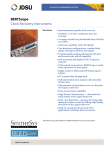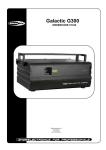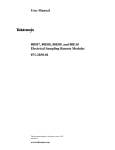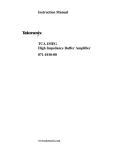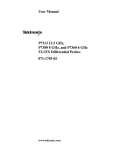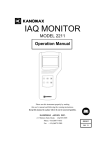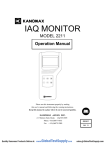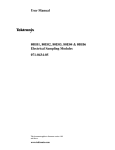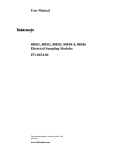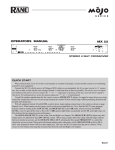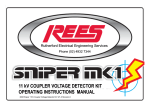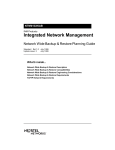Download Tektronix 80A07 Electrical Clock Recovery Module
Transcript
xx ZZZ 80A07 Electrical Clock Recovery Instrument User Manual *P071219502* 071-2195-02 xx ZZZ 80A07 Electrical Clock Recovery Instrument User Manual www.tektronix.com 071-2195-02 Copyright © Tektronix. All rights reserved. Licensed software products are owned by Tektronix or its subsidiaries or suppliers, and are protected by national copyright laws and international treaty provisions. Tektronix products are covered by U.S. and foreign patents, issued and pending. Information in this publication supersedes that in all previously published material. Specifications and price change privileges reserved. TEKTRONIX and TEK are registered trademarks of Tektronix, Inc. Contacting Tektronix Tektronix, Inc. 14200 SW Karl Braun Drive P.O. Box 500 Beaverton, OR 97077 USA For product information, sales, service, and technical support: In North America, call 1-800-833-9200. Worldwide, visit www.tektronix.com to find contacts in your area. Warranty Tektronix warrants that this product will be free from defects in materials and workmanship for a period of one (1) year from the date of shipment. If any such product proves defective during this warranty period, Tektronix, at its option, either will repair the defective product without charge for parts and labor, or will provide a replacement in exchange for the defective product. Parts, modules and replacement products used by Tektronix for warranty work may be new or reconditioned to like new performance. All replaced parts, modules and products become the property of Tektronix. In order to obtain service under this warranty, Customer must notify Tektronix of the defect before the expiration of the warranty period and make suitable arrangements for the performance of service. Customer shall be responsible for packaging and shipping the defective product to the service center designated by Tektronix, with shipping charges prepaid. Tektronix shall pay for the return of the product to Customer if the shipment is to a location within the country in which the Tektronix service center is located. Customer shall be responsible for paying all shipping charges, duties, taxes, and any other charges for products returned to any other locations. This warranty shall not apply to any defect, failure or damage caused by improper use or improper or inadequate maintenance and care. Tektronix shall not be obligated to furnish service under this warranty a) to repair damage resulting from attempts by personnel other than Tektronix representatives to install, repair or service the product; b) to repair damage resulting from improper use or connection to incompatible equipment; c) to repair any damage or malfunction caused by the use of non-Tektronix supplies; or d) to service a product that has been modified or integrated with other products when the effect of such modification or integration increases the time or difficulty of servicing the product. THIS WARRANTY IS GIVEN BY TEKTRONIX WITH RESPECT TO THE PRODUCT IN LIEU OF ANY OTHER WARRANTIES, EXPRESS OR IMPLIED. TEKTRONIX AND ITS VENDORS DISCLAIM ANY IMPLIED WARRANTIES OF MERCHANTABILITY OR FITNESS FOR A PARTICULAR PURPOSE. TEKTRONIX’ RESPONSIBILITY TO REPAIR OR REPLACE DEFECTIVE PRODUCTS IS THE SOLE AND EXCLUSIVE REMEDY PROVIDED TO THE CUSTOMER FOR BREACH OF THIS WARRANTY. TEKTRONIX AND ITS VENDORS WILL NOT BE LIABLE FOR ANY INDIRECT, SPECIAL, INCIDENTAL, OR CONSEQUENTIAL DAMAGES IRRESPECTIVE OF WHETHER TEKTRONIX OR THE VENDOR HAS ADVANCE NOTICE OF THE POSSIBILITY OF SUCH DAMAGES. [W2 – 15AUG04] Table of Contents General Safety Summary . . . . . . . . . . . . . . . . . . . . . . . . . . . . . . . . . . . Environmental Considerations . . . . . . . . . . . . . . . . . . . . . . . . . . . . . . . Preface . . . . . . . . . . . . . . . . . . . . . . . . . . . . . . . . . . . . . . . . . . . . . . . . . . . iii v vii Manual Structure . . . . . . . . . . . . . . . . . . . . . . . . . . . . . . . . . . . . . . . . . . . . . . . . vii Getting Started . . . . . . . . . . . . . . . . . . . . . . . . . . . . . . . . . . . . . . . . . . . . 1 Clock Recovery . . . . . . . . . . . . . . . . . . . . . . . . . . . . . . . . . . . . . . . . . . . . . . . . . Key Features . . . . . . . . . . . . . . . . . . . . . . . . . . . . . . . . . . . . . . . . . . . . . . . . . . . . Installation . . . . . . . . . . . . . . . . . . . . . . . . . . . . . . . . . . . . . . . . . . . . . . . . . . . . . Electrostatic Discharge . . . . . . . . . . . . . . . . . . . . . . . . . . . . . . . . . . . . . . . . Static-Controlled Workstation . . . . . . . . . . . . . . . . . . . . . . . . . . . . . . . . . . . Getting Acquainted with Your Instrument . . . . . . . . . . . . . . . . . . . . . . . . . . . . . Input and Output Connector Care . . . . . . . . . . . . . . . . . . . . . . . . . . . . . . . . Setting up the 80A07 . . . . . . . . . . . . . . . . . . . . . . . . . . . . . . . . . . . . . . . . . . . . . Remote Interface . . . . . . . . . . . . . . . . . . . . . . . . . . . . . . . . . . . . . . . . . . . . . . . . Remote Control . . . . . . . . . . . . . . . . . . . . . . . . . . . . . . . . . . . . . . . . . . . . . . . . . User Adjustments . . . . . . . . . . . . . . . . . . . . . . . . . . . . . . . . . . . . . . . . . . . . . . . . Accessories . . . . . . . . . . . . . . . . . . . . . . . . . . . . . . . . . . . . . . . . . . . . . . . . . . . . . 1 2 3 3 4 5 6 7 9 9 9 9 Reference . . . . . . . . . . . . . . . . . . . . . . . . . . . . . . . . . . . . . . . . . . . . . . . . . 11 Clock Recovery Basics . . . . . . . . . . . . . . . . . . . . . . . . . . . . . . . . . . . . . . . . . . . . User Interface . . . . . . . . . . . . . . . . . . . . . . . . . . . . . . . . . . . . . . . . . . . . . . . . . . . Standards Coverage . . . . . . . . . . . . . . . . . . . . . . . . . . . . . . . . . . . . . . . . . . . . . . 11 14 14 Specifications . . . . . . . . . . . . . . . . . . . . . . . . . . . . . . . . . . . . . . . . . . . . . 19 Certifications . . . . . . . . . . . . . . . . . . . . . . . . . . . . . . . . . . . . . . . . . . . . . . . . . . . 24 80A07 Clock Recovery User Manual i Table of Contents ii 80A07 Clock Recovery User Manual General Safety Summary Review the following safety precautions to avoid injury and prevent damage to this product or any products connected to it. To avoid potential hazards, use this product only as specified. Only qualified personnel should perform service procedures. While using this product, you may need to access other parts of a larger system. Read the safety sections of the other component manuals for warnings and cautions related to operating the system. To Avoid Fire or Personal Injury Use Proper Power Cord. Use only the power cord specified for this product and certified for the country of use. Connect and Disconnect Properly. Do not connect or disconnect probes or test leads while they are connected to a voltage source. Ground the Product. This product is grounded through the grounding conductor of the power cord. To avoid electric shock, the grounding conductor must be connected to earth ground. Before making connections to the input or output terminals of the product, ensure that the product is properly grounded. Do not apply a potential to any terminal, including the common terminal, that exceeds the maximum rating of that terminal. Power Disconnect. The power cord disconnects the product from the power source. Do not block the power cord; it must remain accessible to the user at all times. Do Not Operate Without Covers. Do not operate this product with covers or panels removed. Do Not Operate With Suspected Failures. If you suspect there is damage to this product, have it inspected by qualified service personnel. Avoid Exposed Circuitry. Do not touch exposed connections and components when power is present. Use Proper Fuse. Use only the fuse type and rating specified for this product. Do Not Operate in Wet/Damp Conditions. Do Not Operate in an Explosive Atmosphere. Keep Product Surfaces Clean and Dry. Provide Proper Ventilation. Refer to the manual’s installation instructions for details on installing the product so it has proper ventilation. 80A07 Clock Recovery User Manual iii General Safety Summary Terms in this Manual These terms may appear in this manual: WARNING. Warning statements identify conditions or practices that could result in injury or loss of life. CAUTION. Caution statements identify conditions or practices that could result in damage to this product or other property. Symbols and Terms on the Product These terms may appear on the product: H DANGER indicates an injury hazard immediately accessible as you read the marking. H WARNING indicates an injury hazard not immediately accessible as you read the marking. H CAUTION indicates a hazard to property including the product. The following symbol(s) may appear on the product: iv CAUTION Refer to Manual WARNING High Voltage Earth Terminal Chassis Ground Protective Ground (Earth) Terminal Standby 80A07 Clock Recovery User Manual Environmental Considerations This section provides information about the environmental impact of the product. Product End-of-Life Handling Observe the following guidelines when recycling an instrument or component: Equipment Recycling. Production of this equipment required the extraction and use of natural resources. The equipment may contain substances that could be harmful to the environment or human health if improperly handled at the product’s end of life. In order to avoid release of such substances into the environment and to reduce the use of natural resources, we encourage you to recycle this product in an appropriate system that will ensure that most of the materials are reused or recycled appropriately. The symbol shown to the left indicates that this product complies with the European Union’s requirements according to Directive 2002/96/EC on waste electrical and electronic equipment (WEEE). For information about recycling options, check the Support/Service section of the Tektronix Web site (www.tektronix.com). Restriction of Hazardous Substances This product has been classified as Monitoring and Control equipment, and is outside the scope of the 2002/95/EC RoHS Directive. This product is known to contain lead, cadmium, and hexavalent chromium. 80A07 Clock Recovery User Manual v Environmental Considerations vi 80A07 Clock Recovery User Manual Preface This is the user manual for the 80A07 Electrical Clock Recovery instrument. The manual covers capabilities, installation, operation, and specifications of the instrument. Manual Structure This manual is composed of the following chapters: H Getting Started provides a brief product description and how to install your instrument. Information about accessories to use with your product is also found here. H Reference provides more detail on the funtions and capabilites of the instrument. H Specifications lists the specifications for this instrument. 80A07 Clock Recovery User Manual vii Preface viii 80A07 Clock Recovery User Manual Getting Started This section contains information on key features of your instrument, installing your instrument, and getting acquainted with the controls. Clock Recovery Many communication standards now specify that jitter testing must be carried out using a reference clock that has been derived from the data signal. Typical phase lock loop (PLL) characteristics are specified in terms of the --3 dB bandwidth of the recovery loop, the rate of rolloff of the frequency response, and the degree of response peaking allowable. The 80A07 measures and displays the PLL frequency response from 100 kHz to 12 MHz. The 80A07 allows full control of parameters including loop bandwidth (LBW), peaking/damping and rolloff. Design and test engineers can now find and lock onto signals of undefined or unknown data rates. The engineer can recover full-rate clocks, including spread spectrum clocks, for signals at data rates from 100 Mb/s to 12.5 Gb/s. The engineer has full control of key parameters for variable-loop bandwidth, peaking/damping and first and second order rolloffs, optimizing jitter tracking. Golden PLL Recover Clocks for Optical Storage, Enterprise and Telecom Testing Many test standards require the use of a Golden PLL (phase lock loop.) To assure repeatability, most serial data compliance test standards specify the PLL characteristics for jitter measurement. Each standard provides an optimum LBW setting for clock recovery, often called the Golden PLL. The 80A07 has been designed to provide users with flexibility and accuracy in compliance measurements. It is ideal for optical test applications, like 4x/8x Fibre Channel and 10G Ethernet standards, where the signal under test must be split off and converted from optical to electrical before being fed into the clock recovery data input. The 80A07 recovers a full-rate clock up to 12.5 Gb/s, an important requirement for testing XFP and other 10 Gb/s MSA modules. 80A07 Clock Recovery User Manual 1 Getting Started Key Features The 80A07 provides a quality clock recovery solution with the following features: H 100 Mb/s to 12.5 Gb/s continuous data rate coverage H Accurate variable loop bandwidth from 100 kHz to 12 MHz H Auto lock capability with LED display H Programmable peaking adjustment with first and second order rolloff capability H Self-measured and displayed (Phase Locked Loop) PLL frequency response H USB control connection or stand-- alone operation via front panel H Single-ended or differential 50 Ω data inputs/outputs H DC coupled data through path H Full and divided clock outputs with selectable divide ratios H Measurement of clock phase deviation as a function of frequency and time H Data measurement capability H 2 Edge Density Measurement determines the mark density of the signal under test H Ideal for spread spectrum clock (SSC) applications with large frequency excursions H Four memory locations for saving user setups 80A07 Clock Recovery User Manual Getting Started Installation To install the 80A07, connect the supplied AC power cord to a properly grounded AC supply. The input voltage requirement is 100 VAC to 240 VAC at 50 Hz to 60 Hz. Press the power button on the instrument using the front-panel On/Standby switch. AC power connector Power button Figure 1: Installation Electrostatic Discharge To prevent electrostatic damage, follow the precautions described in this manual and in the documentation provided with any connecting instruments. Circuitry in the instrument is very susceptible to damage from electrostatic discharge or from overdrive signals. Be sure to only operate in a static-controlled environment. Be sure to discharge to ground any electrostatic charge that may be present on the center and outer connectors of cables before attaching the cables. 80A07 Clock Recovery User Manual 3 Getting Started Know your signal source. If it is capable of delivering overvoltages, it is safer to not depend on the signal source settings for protection, but instead use an external attenuator that protects the input from the worst-case conditions. For example, for a 10 V maximum source connected to a 1 V maximum input, use a 10X attenuator. Where possible, connect your cables to the signal source first, and to the instrument second. CAUTION. To prevent damage from electrostatic discharge, install the 50 Ω terminations on the I/O connectors when the connectors are not in use. To prevent damage to the instrument, discharge to ground any electrostatic charge that may be present on the center and outer conductors of cables before attaching the cables to the instrument. To prevent damage to the instrument, do not create an ESD antenna by leaving cables dangling off the input with the other end open. Always use a wrist strap when making signal connections. Wear antistatic clothing and work in a static-free workstation. To prevent damage to the instrument, do not apply a signal outside the Maximum Input Voltage Swing. Static-Controlled Workstation 4 For information on creating a static-controlled workstation, consult the Electronic Industries Association document, EIA-625; Requirements for Handling Electrostatic-Discharge-Sensitive (ESDS) Devices. 80A07 Clock Recovery User Manual Getting Started Getting Acquainted with Your Instrument Data input Loop through data output (terminate with 50 Ω when not in use) General Purpose knob: - Adjust settings - Scroll through menus - Push to confirm settings Recovered clock with programmable sub-rates Lock button — Press to initiate manual locking. Lock range, min 10 MHz, max 500 MHz Lock status indicator Green - locked Amber - locking Red - unable to lock Ground for antistatic strap Measured values Left and right cursor buttons Escape button — Exit submenus and revert to previous values Power on button Enter button: - Scroll through menus - Change digits when editing - Select settings for adjustment - Confirm editing changes Device settings Status indicators Figure 2: 80A07 front panel and display 80A07 Clock Recovery User Manual 5 Getting Started Edge Density. The instrument measures and displays the average edge density of the input data. Phase Deviation. The clock extraction circuit produces a phase difference between incoming data and CR clock output. The phase deviation is displayed in % peak-peak and %RMS. Device Settings. Nominal frequency of the data input signal, loop bandwidth, and peaking (up to 6 dB) are configurable on the front panel display. Standards. 24 preprogrammed industry standards available via the front panel interface. Custom settings can be programmed and saved. Figure 3: 80A07 display details AC power connector USB Auxiliary output connectors Figure 4: 80A07 rear panel Input and Output Connector Care The input and output connectors on the front panel are highly sensitive connectors providing high-frequency signal connections. To maintain signal integrity, it is important not to damage these connectors. Never attach a cable to a connector if the cable has a worn or damaged connector because you may damage the connector. When attaching or removing a cable from the connectors, align the connectors carefully before turning the nut. Then turn only the nut, not the cable. Use light finger pressure to make the initial connection, then tighten the nut lightly with a wrench. 6 80A07 Clock Recovery User Manual Getting Started CAUTION. To prevent electrostatic damage to the 80A07 and other instrumentation, follow the precautions described in this manual and in the documentation provided with any connecting instruments. (See Electrostatic Discharge starting on page 3.) NOTE. For best repeatability and to prolong connector life, use a torque wrench, and tighten the connection to the range of 79-112 N⋅cm (7-10 in lb). If the connectors receive heavy use, such as in a production environment, you should install adapters to make connections. Setting up the 80A07 After the proper connections have been made for data input and clock out, and the instrument has been powered on, you may adjust the input settings. NOTE. The DATA OUTPUT connectors must be terminated if not in use, or else the reflections that result will severely degrade performance. Current settings are displayed on the right side of the display. Use the knob or cursor buttons to scroll through menu items. Press the knob or enter button to select an item to adjust. Use the ESC button to back out of a menu or cancel an adjustment. When editing a numeric setting, use the left and right cursor buttons to move through digits and use the knob to make changes. Press the knob or ENTER button to accept a change, or press the ESC button to cancel changes. Many industry standards are also available from the front panel menu. After selecting a standard, the nominal data rate, loop bandwidth and peaking settings are entered automatically. You can manually enter the following settings: H Nominal Data Rate Nominal rate of the recovered clock. H Lock Range The frequency range around the nominal rate that will be scanned during locking. H Bandwidth Bandwidth of the recovery loop measured at --3 dB. H Peaking Peaking of the recovery loop. Also sets 1st or 2nd order roll-off of untracked jitter. H Nominal Edge Density Expected edge density of incoming data. Required to set bandwidth correctly. 80A07 Clock Recovery User Manual 7 Getting Started H Edge Density Mode Sets bandwidth. Calculations are based on the Expected Edge Density (user entered) or edge density measured during lock. H Clock Amplitude Output amplitude of the full-rate clock. H Sub-rate Amplitude Output amplitude of the sub-rate clock. H Sub-rate Division Division ratio of the sub-rate clock. All settings are saved automatically at power off and restored at power on. You can also save current settings to one of four Setups that can be recalled later. The left side of the display provides several continuously updated measurements: H Frequency The measured frequency of the recovered clock. H Phase Error The peak-to-peak phase error between the incoming data and the recovered clock. This measured value increases if jitter is present on the input data that is not being tracked by the recovered clock. H Phase Error RMS The RMS phase error between the incoming data and the recovered clock. H Lock State Reports whether the CR is locked, unlocked, or in the process of locking. By default, the 80A07 is configured in Auto Lock Mode, where it automatically attempts to acquire lock if the detected Phase Error exceeds the Phase Error Limit setting or if the recovered clock is unstable. The user may force a relock at any time by pressing the Lock button. You can utilize the 80A07 with a Tektronix sampling oscilloscope such as the DSA8200 Digital Serial Analyzer, to display the data input. Use the clock output to trigger the oscilloscope. Figure 5 shows a typical setup configuration. Figure 5: Typical setup configuration 8 80A07 Clock Recovery User Manual Getting Started Remote Interface The 80A07 can be remotely controlled via the virtual front panel software. The virtual front panel software can be installed on a personal computer or a Tektronix sampling oscilloscope. Connection to the 80A07 is made through the USB interface. The virtual front panel software requires the Microsoft Windows 2000 or XP operating system. The virtual front panel software is provided on the CDROM included with your instrument. Insert the CDROM into the CDROM drive and follow the installation prompts. Refer to the user instructions on the CDROM for operation of the virtual front panel software. Remote Control Remote control of the 80A07 is possible with the use of the Software Developer’s Kit (SDK). The SDK is available on the CDROM provided with your instrument. Refer to the instructions provided on the CDROM for use of the developer’s kit. User Adjustments The 80A07 contains no user adjustments. 80A07 Clock Recovery User Manual 9 Getting Started Accessories This section lists the standard and optional accessories available for the instrument. Standard Accessories The following accessories are shipped with the instrument: Table 1: Standard accessories Item 80A07 Electrical Clock Recovery User Manual Part number 071-- 2195-- xx 80A07 Software disc (Virtual Front Panel and software developer’s kit) 063-- 4040-- xx Power Cord 161-- 0104-- xx Rack mount hardware Optional Accessories Left bracket 119-- 7360-- xx Right bracket 119-- 7361-- xx Hardware bag (screws) 119-- 7363-- xx USB cable 174-- 4401-- xx Fuse 119-- 7362-- xx You can order the following accessories for use with the 80A07. Consult a current Tektronix catalog for additions, changes, and details: Table 2: Optional accessories 10 Item Part number Cables (450 mm/18 inch; 1 dB loss @ 20 GHz) recommended for work to 20 GHz. 015-- 0560-- xx SMA male 50 Ω termination 015-- 1022-- xx Connector saver, 3.5 mm SMA 015-- 0549-- xx SMA accessory kit 020-- 1693-- xx 80A07 Clock Recovery User Manual Reference Clock Recovery Basics A clock recovery system is used to generate a sampling clock from a stream of data with an embedded clock. The sampling clock is then used by the decision circuit to determine when to decide the logic state of the incoming data. In most cases, the data is line coded in a format referred to as “Non-Return to Zero” (NRZ). As the name implies, the logic state in NRZ data remains constant when the data contains a series of bits with the same value, 1 or 0. Data 1 0 0 1 1 0 1 Clock Jitter Transfer Loop Response Peaking The clock recovery PLL (phased lock loop) removes virtually all of the low frequency jitter from the input data and none of the very high frequency jitter components. Periodic jitter with frequency components near the roll slope of the PLL loop response will be attenuated by some degree. The Jitter Transfer Function is a plot of the attenuation of the jitter passing from the input data to the recovered clock output as a function of frequency content. The Jitter Transfer Function is not exactly an inverse of the PLL loop frequency response. The slope of the jitter transfer function, as well as its peaking will often be different that of the PLL loop response. 80A07 Clock Recovery User Manual 11 Reference Jitter Transfer Function (roll off varies between 20 - 40 dB/decade) PLL Loop Response (constant 20 dB/decade roll off) The parameters which determine the JTF roll off slope and peaking are the relationship between loop bandwidth and the bit rate, and the amount of peaking in the PLL response. Several examples of the jitter transfer function versus PLL loop response can be seen in the next section. The 80A07 has the ability to measure the PLL response and the jitter transfer function and display a plot of these to the user. This can be useful to understand the relationship of these parameters at the particular data rate. Golden PLL Many test standards require the use of a Golden PLL (phase lock loop.) The 80A07 is an instrumentation grade clock recovery system. The PLL parameters of clock frequency, loop bandwidth and peaking are accurately calibrated, and adjustable by the user. This is useful in two situations — during transmitter testing when the user wants to measure parameters in the data signal through the channel exactly as the receiver would, and for standards compliance testing. Because the clock recovery system removes the low frequency jitter from the regenerated clock, the loop parameters must be calibrated and set to known values for repeatable jitter measurements. To assure repeatability, most serial data compliance test standards specify the PLL characteristics for jitter measurement. A PLL which is set to these specified parameters is often referred to as a “Golden PLL”. Edge Density 12 The logic state of NRZ data does not change between successive bits of the same logic state. Therefore, there will not be a logic edge in every bit time slot, or Unit Interval. The edge density refers to the average percentage of unit intervals which contain a transition. A repeating 1010 pattern has a transition occurring during every unit interval, and therefore an edge density of 100%. A Pseudo Random Bit Stream (PRBS) pattern has an edge density of 50%. Other examples 80A07 Clock Recovery User Manual Reference include a repeating 1100 pattern, which has a 50% edge density, and a repeating 11110000 pattern, which would have an edge density of 25%. All clock recovery systems require a minimum edge density to operate properly. If a long pattern of all ones or zeros were sent, the clock recovery would not be able to track jitter or spread spectrum clock (SSC) modulation or may even lose lock on the data clock. Data encoding standards eliminate this possibility by either modulating the bit stream using a set of rules that set a minimum for the number of consecutive bits set to the same logic state, or add overhead data bits to the packet which guarantee transitions occur even when the payload data is bit stream of only one logic state. The edge density represents the amount of energy going into the clock recovery phase lock loop. The average energy effects the parameters of loop gain and bandwidth. Therefore, an instrumentation grade clock recovery system such as the 80A07 requires information on the edge density to keep the loop parameter settings calibrated. In the 80A07, this can be done by one of two methods, auto and manual modes. In auto mode, the actual average edge density is measured and automatically calibrates the loop parameter settings. In manual mode, the user enters the expected edge density. A warning message is generated when the measured edge density varies greatly from the expected edge density. Some serial data compliance standards, such as SATA, require the loop parameters be calibrated to a specified edge density, regardless of the edge density of the actual data. Clock Multiplication and Division To lock to NRZ data, the phase detector used in a clock recovery PLL does not require an edge at every unit interval. This property can be utilized to multiply a clock frequency. The PLL will lock to a frequency that is a multiple of the clock applied to the data input. To multiply a clock, you enter the desired output frequency as the clock frequency. This must be an integer multiple of the input frequency. To calibrate the loop response (for known jitter transfer performance), you also enter the preclinical of the multiplication factor in percent as the expected edge density. For example, for 2X multiplication, enter 50 %, for 3x enter 33 %, for 5x enter 20 % etc. The clock recovery unit will phase lock to the multiple of the input data frequency, providing a clean multiple of the input clock at the output. While the PLL can accept data with edges at a sub-multiple of the clock rate, it can handle the converse -- edge rates greater than one per unit interval (corresponding to edge densities greater than 100%). Thus, the PLL itself can not be used directly to divide a clock to a lower multiple. The 80A07 provides an additional Sub-Rate Clock output which is divided to a sub multiple of the main clock output. The 80A07 utilizes a user programmable divider for this purpose. The divider is specifically designed to minimize the addition of jitter to the recovered clock signal. This sub-rate clock output can be used to precisely divide a clock down to a sub multiple frequency. The 80A07 80A07 Clock Recovery User Manual 13 Reference provides a large selection of division ratios, ranging from 1 to 648. To use the clock recovery instrument as a precision clock divider, you would set the clock frequency to the actual input frequency and the edge density to 100%. Then, select the desired division ratio for the SUBRATE CLOCK output. Note that because the divider circuits are located outside of the PLL, the calibrated loop characteristics and jitter transfer function will scale in frequency by the sub-rate divisor. User Interface The 80A07 can be used in standalone operation or in conjunction with a Tektronix sampling oscilloscope. As a standalone instrument, information is always immediately available on the front panel display, showing parameters such as the PLL bandwidth, lock status, bit rate, peaking and rolloff. For easy verification of compliance, the correct characteristics are automatically set when a given standard is selected from a pull-down menu. However, full control of parameters is possible with direct entry of the user parameters. The 80A07 has variable jitter peaking, allowing jitter gain in excess of 10 dB if desired. Remote control of the instrument is supported via USB and a software developer’s kit. The 80A07 instrument provides a solution for triggering a DSA8200, CSA8000, and TDS8000 Series instruments from single-ended or differential electrical signals. The 80A07 can be used as a standalone clock recovery device or in conjunction with the following Tektronix sampling oscilloscopes: H DSA8200 Digital Serial Analyzer H CSA8000, CSA8000B, and CSA8200 Communications Signal Analyzer (With product software version 2.0 or later) H TDS8000, TDS8000B, and TDS8200 Digital Sampling Oscilloscope (With product software version 2.0 or later) Standards Coverage The following graphics show compliance settings, and the accompanying table (Table 3) show common standards, the data rates they employ, and the loop bandwidths required for compliance measurements. 14 80A07 Clock Recovery User Manual Loop Reponse (dB) Reference 0 Blue trace: Jitter Transfer Function (roll off varies between 20 - 40 dB/decade) - 10 Red trace: PLL Loop Response (constant 20 dB/decade roll off) - 20 - 30 - 40 10kHz Legend 100kHz 1MHz 10MHz 100MHz 10 Gigabit Ethernet Bit Rate: 10.3125 Gb/s Loop Bandwidth: 4 MHz Peaking: 0 dB XAUI Bit Rate: 3.125 Gb/s Loop Bandwidth: 1.875 MHz Peaking: 0 dB 2x Fibre Channel Bit Rate: 2.12 Gb/s Loop Bandwidth: 1.275 MHz Peaking: 0.3 dB max 4x Fibre Channel Bit Rate: 4.25 Gb/s Loop Bandwidth: 2.55 MHz Peaking: 0.3 dB max 8x Fibre Channel Bit Rate: 8.5 Gb/s Loop Bandwidth: 5.1 MHz Peaking: 0.3 dB max 8x OIF CEI 6G+ Bit Rate: 6.25 Gb/s Loop Bandwidth: 3.6 MHz Peaking: 0.1 dB max OIF CEI 11G+ Bit Rate: 11.0 Gb/s Loop Bandwidth: 4 MHz Peaking: 0.1 dB max OIF CEI 11G+ Bit Rate: 11.0 Gb/s Loop Bandwidth: 6 MHz Peaking: 0.1 dB max OIF CEI 11G+ Bit Rate: 11.0 Gb/s Loop Bandwidth: 8 MHz Peaking: 0.1 dB max Serial ATA Gen 2 fbaud/500 Bit Rate: 3.0 Gb/s Loop Bandwidth: 6 MHz Peaking: 2.1 dB Serial ATA Gen 2 fbaud/1667 Bit Rate: 3.0 Gb/s Loop Bandwidth: 0.9 MHz Peaking: 0 dB SONET OC-- 48/SDH STM-- 16 Bit Rate: 2.488 Gb/s Loop Bandwidth: 1 MHz Peaking: 0 dB SONET OC-- 192/SDH STM-- 64 Bit Rate: 9.95 Gb/s Loop Bandwidth: 4 MHz Peaking: 0 dB XFP/XFI Bit Rate: 10.5 Gb/s Loop Bandwidth: 8 MHz Peaking: 0.1 dB max Fully Buffered DIMM II Bit Rate: 6.4 Gb/s Loop Bandwidth: 11 MHz Peaking: 0.5 dB PCI Express II Bit Rate: 5.0 Gb/s Loop Bandwidth: 5 MHz Peaking: 1 dB max 80A07 Clock Recovery User Manual 15 Reference Table 3: Standards supported Data Rate (Gb/s) Standard Ethernet Fibre Channel OIF CEI1 SATA2 1.0 XFP/XFI 10.312 ≤4 XAUI 3.125 1.875 1X 1.063 10 0.638 0.3 max 2X 2.12 20 1.275 0.3 max 4X 4.25 40 2.550 0.3 max 8X 8.5 80 5.100 0.3 max 6+Gb/s 4.976 to 6.375 3.6 (fbaud/1667) 0.1 max 11+Gb/s 9.95 to 11.1 8, ITU 6 (fbaud/1667) other Gen 1 250UI 1.5 15 Slope Spread Spectrum Clocking - 20 dB/ decade No - 20 dB// decade No - 20 dB/ decade No 6.000 fbaud/1667 0.900 5UI 300.000 Yes 2.09 1.25 dB Type 2 6.000 2.09 1.25 dB Type 2 fbaud/1667 1.800 2.09 1.25 dB Type 2 fbaud/10 300.000 2.09 1.25 dB Type 2 fbaud/500 3 30 OC12/STM-4 0.622 0.250 OC48/STM-16 2.488 1.000 OC192/STM-64 9.95 4.000 XFP/XFI Receiver Test 9.95 - 11.2 FB-DIMM1 FB-DIMM2 16 Peaking (dB) 0.637 64 Transmitter Test Fullyy Buffered DIMM Loop Bandwidth (MHz) 10Gb/s Ethernet Transmitter Test Gen 2 SONET// SDH Common Clock Divide Ratios - 20 dB// decade 8.000 0.1 max 4.000 0.1 max - 20 dB/ decade 0.5 to 3 2nd Order 3.2, 4.0 24 11 to 33 4.8 24 11 to 22 4.8, 6.4, 8.0, 9.6 Forwarded Clock 11 to 22 0.5 to 2 No No Yes. Transmitter Test: Full SSC swing. swing Receiver Test: 0.06 UI swing. 80A07 Clock Recovery User Manual Reference Table 3: Standards supported (cont.) Data Rate (Gb/s) Common Clock Divide Ratios Loop Bandwidth (MHz) I 2.5 25 1.500 II 5 50 5 to 16 8 to 16 Standard PCI Express SAS3 Peaking (dB) Slope Spread Spectrum Clocking 1st order with Yes, Optional. - 20 dB/ Receiver Test: decade 65 pps ppk-pk p swingg Up to 1 dB Up to 3 dB 1st or 2nd order Gen 1 fbaud/1667 1.5 15 0.900 1st order (single pole) Gen 2 fbaud/1667 3 30 1.800 1st order (single pole) 1 8 MHz for most tests for ITU applications, BW/1667 other. Minimum of 4 MHz for stress testing in one case. 2 Gen 1 & 2 categories: “i” (internal, hard drives etc.) and “m” (medium reach) use fbaud/500 and fbaud/10 for Gen 2 and 250UI and 5UI for Gen 1. “x” (extended reach) uses fbaud/1667, Type 2. Peaking bandwidths Implied: specified as damping factor of 0.707 min to 1.00 max — conversion taken from Gardner. Loop bandwidths specified with transition density of 1 (100% or 1010101 pattern). Assumption is that loop bandwidth will change proportionally as transition density reduces. 3 Specified as damping factor of 0.707 min to 1.00 max — conversion taken from Gardner. Loop bandwidths specified with transition density of 1 (100% or 1010101 pattern). Assumption is that loop bandwidth will change proportionally as transition density reduces. 80A07 Clock Recovery User Manual 17 Reference 14 12 12 12 10 8 Loop Bandwidth (MHz) 6 6 4 3 2 1.5 1 0 0 2 4 6 8 10 12 14 Date Rate (Gb/s) The 80A07 has a variable loop bandwidth from 100 kHz to 12 MHz. The calibrated loop bandwidth is limited as indicated by the graph. Figure 6: Clock recovery loop bandwidth versus data rate 18 80A07 Clock Recovery User Manual Specifications Specifications Electrical Sampling Modules This section contains specifications for the 80A07 Electrical Clock Recovery instrument. To meet specifications, two conditions must first be met: H The instrument must have been operating continuously for 20 minutes within the operating temperature range specified. H The instrument must be in an environment with temperature, altitude, and humidity within the operating limits described in these specifications Table 4: Characteristics Specifications Characteristics Data inputs / outputs Input configuration True differential Output configuration True differential Unused outputs must be terminated into 50 Ω. Connector type APC 3.5 Impedance 50 Ω Coupling DC Insertion loss - 2.6 dB or better 10 MHz to 12.5 GHz Maximum nondestruct range 5 Vpk-pk Maximum operating range 5 Vpk-pk Input sensitivity Single ended 30 mVpp at 10 Gbps Differential 15 mVpp at 10 Gbps Clock output Connector type APC 3.5 Impedance 50 Ω Coupling DC Amplitude Minimum 300 mVpp Typical 540 mVpp 80A07 Clock Recovery User Manual 19 Specifications Table 4: Characteristics (cont.) Specifications Characteristics Amplitude accuracy 10% or 30 mV Duty cycle accuracy 3% UI Jitter RMS, at 800 mVpp input, 10 Gps, 1010 pattern, 2 MHz BW, 0.5 dB peaking Typical 70 fsec Maximum 250 fsec Return Loss - 15 dB minimum Rise/Fall 80/20% point measurements Typical 25 ps Maximum 30 ps Subrate output Connector type APC 3.5 Impedance 50 Ω Coupling DC Divider function from main CLOCK OUTPUT Full rate divided by 1, 2, 4, 5, 6, 7, 8, 9, 10, 12, 14, 16, 18, 20, 24, 25, 28, 30, 32, 35, 36, 40, 42, 45, 48, 49, 50, 54, 56, 60, 63, 64, 70, 72, 80, 81, 90, 100, 108, 112, 120, 126, 128, 140, 144, 160, 162, 168, 180, 192, 196, 200, 216, 224, 240, 252, 256, 280, 288, 320, 324, 336, 360, 384, 392, 432, 448, 504, 512, 576, 648. Odd division ratios have non-- 50% duty cycles. Amplitude Adjustable Minimum 250 mVpp Maximum 900 mVpp Amplitude accuracy 10% or 30 mV Measured at div by 1, typically ±25% for all division ratios Duty cycle accuracy 5% UI Measured at div by.1 2 4 8 16 32 64 128 Jitter RMS, at divide-by-1, 800 mVpp input, 10 Gps, 1010 pattern, 2 MHz BW, 0.5 dB peaking. Typical 70 fs Maximum 250 fs Return loss Minimum - 15 dB 100 KHz to 12.5 GHz Rise/fall 20 80/20% point measurements, divide-by-1 Typical 25 ps Maximum 30 ps 80A07 Clock Recovery User Manual Specifications Table 4: Characteristics (cont.) Specifications Characteristics Control interface Type USB 2.0 Uplink ports 1 Additional ports 3 Clock recovery response Loop bandwidth Refer to graph for allowable data rate versus loop bandwidth combination settings, Adjustable Minimum 100 KHz Maximum 12 MHz Frequency rolloff Adjustment of peaking also adjusts the frequency switchover point between low-frequency - 40 dB/decade rolloff rate and high-- frequency - 20 dB/decade rolloff rate. Minimum 20 dB/dec Maximum 40 dB/dec Peaking Adjustable Minimum 0 dB Maximum 6 dB Frequency range Adjustable Minimum 100 Mbps Maximum 12.5 Gbps Frequency deviation +500/-- 5500ppm (+0.05/-- 0.55%) 30-- 33 KHz Modulation Rate Bandwidth deviation ±2% Measured with 1100 pattern at room temperature over 500 kHz to 12 MHz BW setting. Increased deviation for BW settings below 500 KHz. Peaking deviation ±10% of setting or 0.2 dB Measured edge density deviation ±1% Phase error output Linear Volts/UI of phase error depends on edge density and is not calibrated. Bandwidth limited. Connector type SMA Impedance 50 Ω Coupling DC Frequency Track Output Volts/PPM of frequency variation (e.g. 5000 PPM gives 5 Vpp) is not calibrated. Connector type SMA Impedance 50 Ω Coupling DC 80A07 Clock Recovery User Manual 21 Specifications Table 4: Characteristics (cont.) Specifications Characteristics Trigger input External CR lock request Connector type SMA Impedance 50 Ω Coupling DC (to 0 volts) Threshold 1.5 V Pulse width 50 ns minimum Trigger output External lock status indicator Connector type SMA Impedance 50 Ω Coupling DC Latency 300 ms maximum Table 5: Power consumption, fuses, and cooling Specifications Characteristics Source voltage and frequency 100 VAC to 240 VAC at 50 Hz to 60 Hz Fuse rating 3.15 A Power requirements 150 W maximum Table 6: Mechanical Specifications Characteristics Weight 20 lbs (9.1 kg) Overall dimensions 15.5 in. W x 3.75 in. H x 13.75 in. D (394 mm W x 95 mm H x 337 mm x D) The dimensions do not include feet or protruding connectors. Table 7: Environmental specifications Specification Characteristics Dynamics 22 Vibration (operating) Meets MIL-- PRF-- 28800F Class 3 Shock Meets MIL-- PRF-- 28800F Class 3 Bench handling (operating) Meets MIL-- PRF-- 28800F Class 3 80A07 Clock Recovery User Manual Specifications Table 7: Environmental specifications (cont.) Specification Characteristics Atmospherics Temperature Operating +10 °C to +40 °C Nonoperating - 22 °C to +60 °C Relative humidity Operating 20% to 80% relative humidity with a maximum wet bulb temperature of +29 °C at or below +40 °C. Nonoperating 5% to 90% relative humidity with a maximum wet bulb temperature of +29 °C at or b below +60 °C. Altitude Operating 3,000 m (9,842 ft.) Non-operating 12,190 m (40,000 ft.) Table 8: Electromagnetic specifications Specification Characteristic Emissions The instrument meets or exceeds the EMC requirements of the following standards: EN61326-- 1 European Community Requirements Susceptibility The instrument meets or exceeds the EMC requirements of the following standards: EN61326-- 1 European Community Requirements 80A07 Clock Recovery User Manual 23 Specifications Certifications Table 9: Certifications and compliances Category Standards or description EC Declaration of Conformityy - EMC Complies with the following requirements of the EMC directive EN61326: 24 EN 61326 EMC requirements for Class A electrical equipment for measurement, control and laboratory use, Annex D. EN 61000-- 4-- 2 Electrostatic discharge IEC 61000-- 4-- 3 RF electromagnetic field immunity IEC 61000-- 4-- 4 Electrical fast transient / burst immunity IEC 61000-- 4-- 5 Power line surge immunity IEC 61000-- 4-- 6 Conducted RF immunity IEC 61000-- 4-- 11 Voltage dips and interruptions immunity EN 61000-- 3-- 2 AC Power Harmonic Current Emissions EN 61000-- 3-- 3 Voltage changes, fluctuations, and flicker 80A07 Clock Recovery User Manual







































